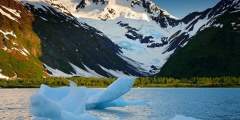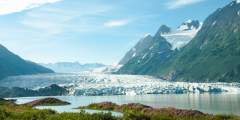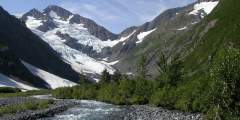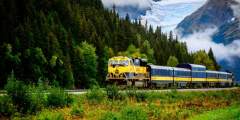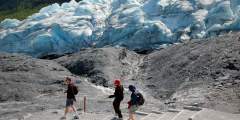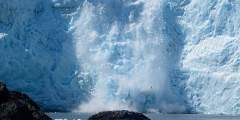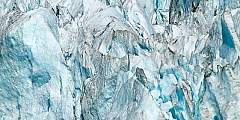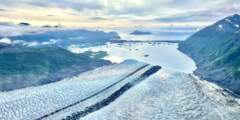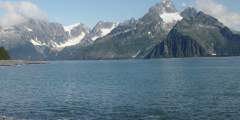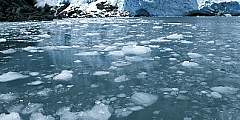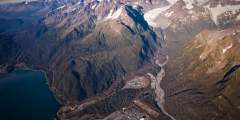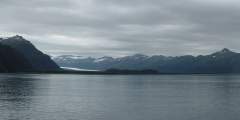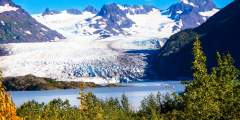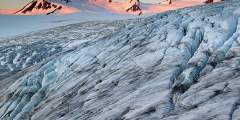Kenai Peninsula Glacier Guide
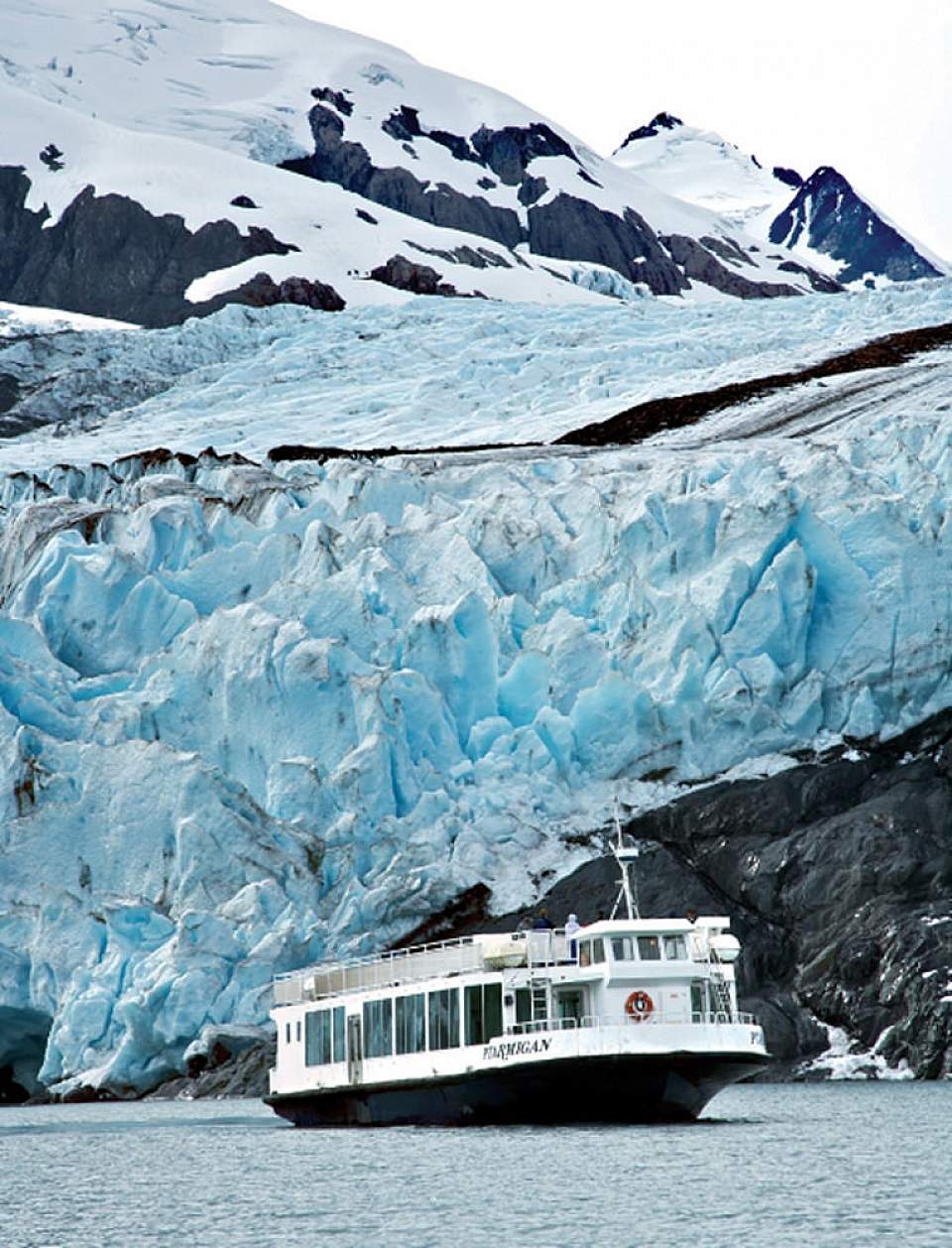
Board the MV Ptarmigan to get close to the face of Portage Glacier
It’s easy to view or explore glaciers on the peninsula—known for its rugged terrain, coastal fiords and deep winter snows. Use our guide to plan your journey or day trip to see Kenai’s active ice.
By road, rail and foot
A half-dozen front-country glaciers can reached by car or train, and then approached by relatively short hikes or (in one case) a quick boat ride. These tongues of ice are among the most popular natural attractions in Alaska.
Portage Glacier
About 50 miles southeast of Anchorage
This very active glacier now hidden inside a lobe of Portage Lake has undergone what may be the most closely watched retreat of any glacier in Alaska. Decades after it exposed its own deep lake, the Begich, Boggs Visitor Center was built specifically to showcase a stunning head-on view of its rugged, collapsing face. Though the glacier finally slipped from easy view in the 1990s and became largely a tour boat destination in summer, Portage continues to generate icebergs that ground within sight of lakeshore parking
Hiking option: Portage Glacier can be approached under human power via the Portage Pass Trail from the Whittier side of the Anton Anderson Memorial Tunnel. Non-motorized boats like kayaks are permitted along the north shore of Portage Lake to the beach at the base of Portage Pass, with a great view of the ice. During winter—once Portage Lake freezes solid—people also walk, ski, ice skate and snow bike about three miles to the vicinity of the glacier’s active face.
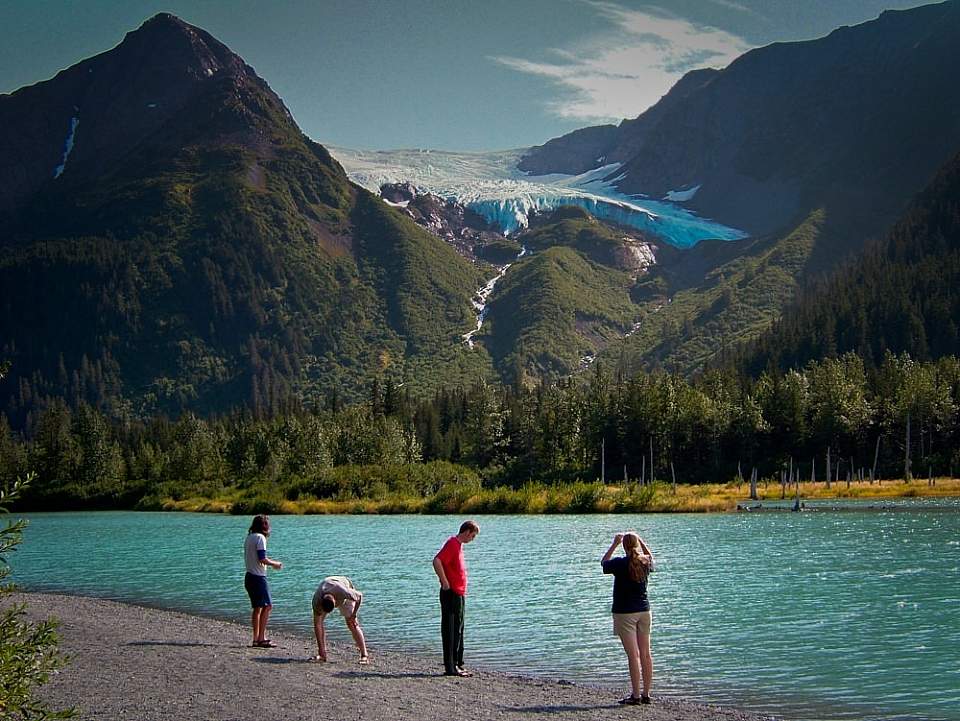
View of Explorer Glacier from Portage Valley
Byron Glacier
About 50 miles southeast of Anchorage
Only a short hike on a flat trail south of Portage Lake near the head of Turnagain Arm, Byron dominates its own gorge-like valley, offering a rugged, remote atmosphere that feels as though you’ve traveled deep into the backcountry. It also hosts a population of ice worms.
Explorer & Middle glaciers
About 50 miles southeast of Anchorage
This pair of classic mountain glaciers gleam from the mountains overlooking Portage Valley, anchoring several spectacular vistas from highway pullouts and the valley’s popular multi-use trail. Both glaciers feed the valley’s stream-and-pond system, creating habitat for migrating salmon, Dolly Varden and rainbow trout.
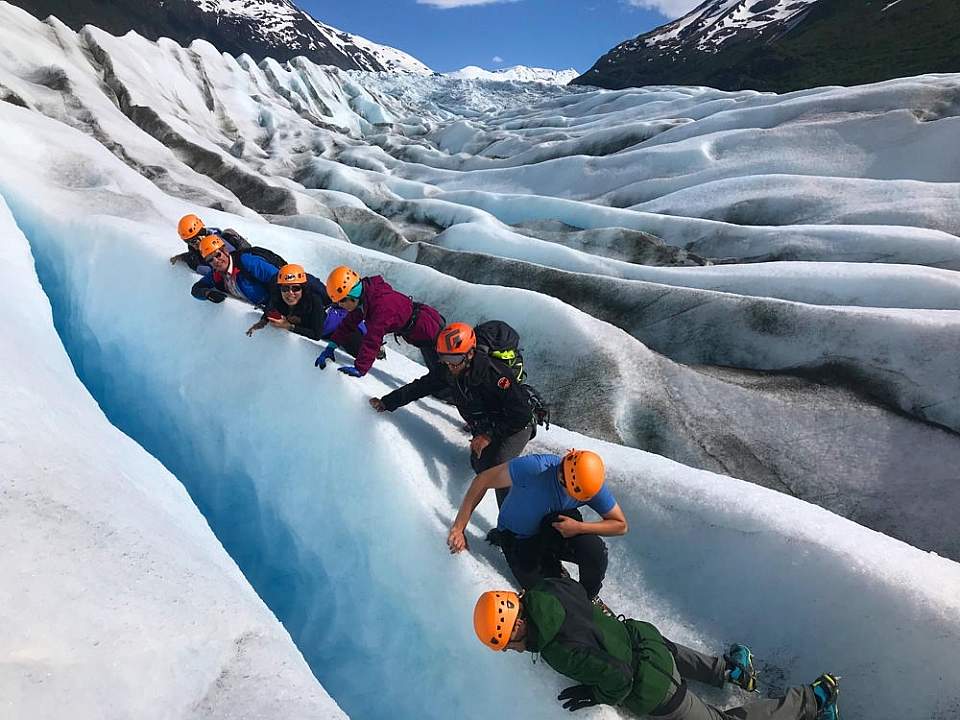
Hike on Spencer Glacier with Ascending Path as your Guide
Spencer Glacier
About 10 miles south of Turnagain Arm on the Alaska Railroad
For a unique, European-style excursion that offers direct access to an active glacier that clogs its lake with amazing icebergs, take a train to the Spencer Glacier Whistlestop station during the summer visiting season. Guides offer activities such as sea kayaking and rafting, hiking and climbing. The U.S. Forest Service maintains a campground (reservations required.) You can backpack a new trail system, rent a public use cabin on a mountain ridge, or explore a basin recently emerging from beneath ice.
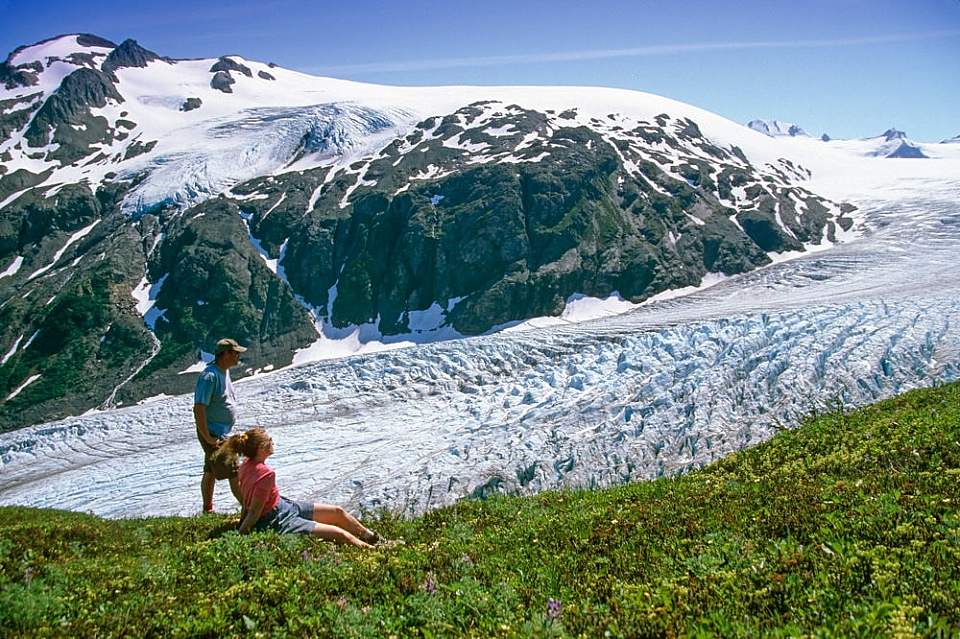
View of Exit Glacier from the Harding Icefield Trail
Exit Glacier
About 12 miles outside Seward on a paved road
This dramatic cascade of ice descends from the massive Harding Ice Field to a visitor center with curated trail system, located inside the only portion of Kenai Fjords National Park reachable by road. Signage identifies the glacier’s terminal locations during its retreat over the decades, making the access trail a real-time index into the dynamics of climate warming. The easy lower trail leads to overlooks of crevasses.
By Boat
Marine tours out of Seward into Resurrection Bay and the Kenai Fjords outer coast deliver exhilarating encounters with tidewater (or near tidewater) glaciers, often calving icebergs while you watch. Several other glittering gems perch in hanging valleys on surrounding slopes. Almost all tours stop at Bear Glacier, the largest of the park’s 38 glaciers, just 17-miles from Seward. Depending upon the trip’s itinerary, you might also see Aialik, Holgate, Pedersen, and Northwestern. And don’t forget—A trip to Kenai Fjords coast also includes world-class viewing of marine wildlife!
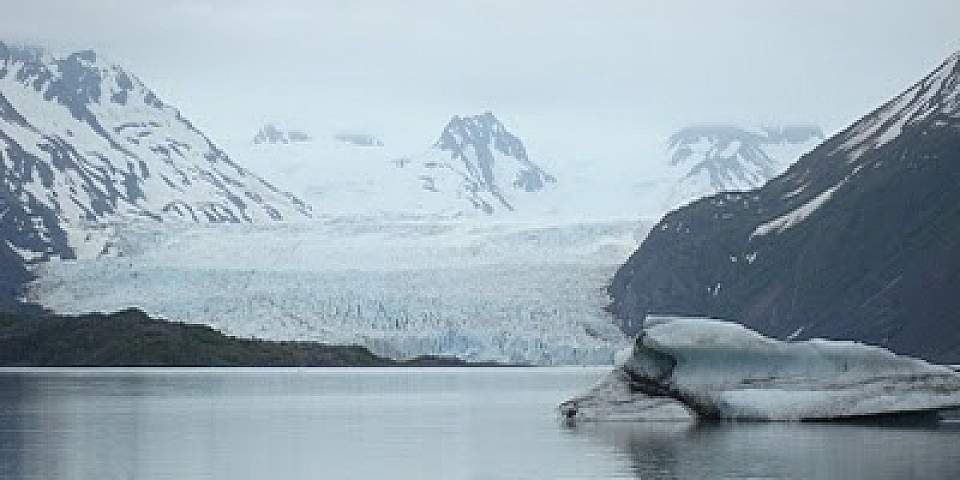
View of Glacier from the Grewingk Glacier Trail in Kachemak Bay State Park
Backcountry Glaciers
Backcountry trips into the Kenai Mountains lead to more glaciers still. Just about every peak and alpine nook between Portage and Seward, or along the upper Kenai River corridor, contains flowing ribbons of ice or stranded remnants—or, sometimes, persistent snowfields on the verge of becoming their own, new glacier. Many can be reached during day hikes. Most have no names.
Other glaciers—perhaps more difficult or requiring a boat to approach—spill from the mountains looming at the head of Skilak and Tustumena lakes, fed by the immense Harding Ice Field. This 700-square-mile ice cap—mother of 38 glaciers that spill from Kenai’s mountainous spine—is most easily accessible by ski plane or a 3,000-foot ascent of the Harding Icefield Trail beside Exit Glacier. In Kachemack Bay State Park, a water taxi ride from Homer will deliver you to the Grewingk Glacier Trail, the most popular attraction in the state park.
Show Map
Glaciers
Most Popular
Gorgeous Portage Glacier lies just 48 miles south of Anchorage. Explore the glacier, visit the museum, and go for a boat ride.
Spencer Glacier rises 3,500 feet in a stunning, natural ramp from a lake of royal-blue icebergs in the Chugach National Forest just 60 miles south of Anchorage. It’s a family-friendly recreation destination featuring camping, hiking, glacier exploration, nature walks, paddling and sightseeing. Maybe best of all: You have to take a train to get there!
This short day hike — with an easily accessible trailhead a few hundred meters from the Begich Boggs Visitor Center — offers you big views of the Byron Glacier.
These gleaming valley glaciers perch in the mountains above Portage Valley, easy to view from highway pullouts. They feed the nearby stream systems that harbor many species of salmon and trout. Tangle Pond and Tangle Creek are favorite fishing spots for locals, and there are lots of places to camp in Portage Valley itself.
You can hike right up to Seward’s Exit Glacier and feel the dense blue ice while listening to it crackle. Walk the lower trail to get a good photo in front of the glacier face. Or, choose the more challenging 7‑mile round-trip Harding Icefield Trail. There is a short ranger-led walk daily at 11am and 3pm, from Memorial Day through Labor Day.
By Boat
Aialik Glacier is the largest glacier in Aialik Bay, located in Kenai Fjords National Park. While fairly stable, the glacier calves most actively in May and June. The glacier is very accessible on a kayak tour or day cruise from Seward.
Pedersen Glacier, located in Kenai Fjords National Park, receded throughout the 20th century exposing Pedersen Spit and Pedersen Lagoon. In the 1980s, the lagoon was designated as the Pedersen Lagoon Wildlife Sanctuary, a 1,700-acre sanctuary meant to preserve and protect the area’s wildlife and land. Take a cruise from Seward to see Pedersen Glacier, and the beautiful habitat surrounding it just under 20 miles away.
Just outside of Seward, Bear Glacier flows down from the Harding Icefield — the largest icefield entirely contained within the United States — into a long, narrow lagoon. It’s the largest glacier in Kenai Fjords National Park, stretching 12 miles from its origin. Experience by air, kayak, paddleboard, or by option for an overnight excursion near the ice.
This glacier, named after Northwestern University in 1909, can be found at the head of Northwestern Fjord in Kenai Fjords National Park, just under 30 miles southwest of Seward. By the second half of the 20th century, Northwestern Glacier’s recession revealed a number of islands in the Fjord that had previously been covered in ice. Take a cruise from Seward and envision the entirety of of Northwestern Fjord filled with ice, as you make your way ...more
Holgate Glacier, found in Holgate Arm in Aialik Bay, within Kenai Fjords National Park, is a tidewater and mountain glacier. While it is one of the smaller glaciers in Aialik Bay, Holgate Glacier is still a popular destination to see calving glaciers. And it is actually advancing! Holgate Arm is often filled with ice, but on a good day you can get to a close and safe distance from the glacier. Catch a cruise from Seward, or go kayaking!
One hundred and fifty years ago the valley now occupied by the ship facility and correctional center was filled with the ice of Godwin Glacier. If you look just below the 4 mountain peaks to the left side of the valley you can see the ice of Godwin glacier. In the year 1850 this glacier calved icebergs into Resurrection Bay waters. Now a days Godwin glacier is a valley glacier and behind the low hills you see in the foreground Godwin glacier… ...more
Both of these photographs were taken from the same location in Nuka Passage, about 6 kilometers (3.7 miles) south of the position of the 1909 terminus of the glacier. The first photograph by D.F. Higgins, is an August 6, 1909 view of the then retreating northern part of the terminus. The absence of any icebergs indicates that by 1909, the glacier was no longer tidewater. When photographed, Yalik Glacier had a gently sloping terminus with… ...more
Look for three alpine glaciers back in Thumb Cove. Alpine glaciers keep their ice in the alpine region of a mountain and don’t descend to a valley floor or the tidewater’s edge. From the left the three are Prospect, Spoon and Porcupine glaciers. Notice the lovely cabin on the edge of Thumb Cove. The land of the Resurrection Peninsula is divided between state park, national forest and private in-holdings. You will see several private cabins.… ...more
Backcountry Glaciers
13-mile glacier in the Kenai Mountains.
The 700-square-mile Harding Icefield, one of four major ice caps in the United States, crowns Kenai Fjords National Park. The icefield may be a remnant of the Pleistocene ice masses once covering half of Alaska. The magnificent coastline of Kenai Fjords is steep valleys that were carved by glaciers in retreat. Active glaciers still calve and crash into the sea as visitors watch from tour boats here. Sea stacks, islets, and tagged shoreline… ...more

